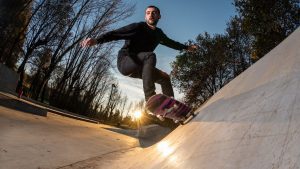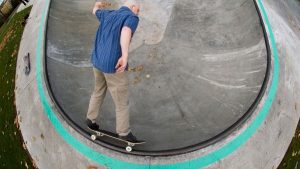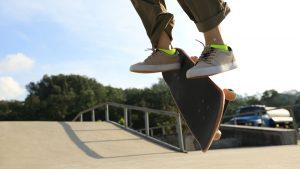What is a skateboard turn technique? Why are these strategies important in skateboarding?

We’ve all been there – heart pounding, skateboarding wheels rolling, and a sharp turn approaching. It is not just about skateboarding speed and skate tricks, it is an exquisite dance between you and your skateboard. But to truly master this art, understanding skateboard turn techniques is crucial.
Key Takeaways
- We’ve created a guide on how to master slide technique. Here, we’ll help and guide you to navigate these skateboard tricky slides with grace and precision. We’ll go deep into skateboard carving techniques, kick turns, power slides, and even some advanced skateboard maneuvers for skateboarders seeking to take their skills up a notch.
- We’ll also provide skateboard tips on safety and practice on turning easier to ensure you’re having a safe and successful skateboarding experience. Whether you’re new to the world of skateboarding, a seasoned pro skateboarder, or somewhere in between, our skateboard turning technique guide can help you make the most of your skateboarding adventure.
- We’ll cover all aspects of skateboard turns, from the basics like pushing, leaning, and rotating to more complex techniques like manuals, slides, and grabs.
- We’ll also discuss the different types of skateboards and what makes them unique.
So whether you’re looking to better understand the finer points of rotating, or just want to brush up on the fundamentals, this guide is here to help you. We invite you to join us on this thrilling journey as we strive to become better skateboarders while serving our community with respect and safety awareness. Read this article first before you begin riding!
Understanding The Basics Of Skateboarding Turn Strategies
There’s nothing quite like the thrill of mastering your riding skills- feeling it respond to your slightest movement as if it’s a part of you. At FamilyHype, we understand the importance of making the right skateboard and gear choices when starting. That’s why we make sure to guide our readers on the basics of skateboarding, from skateboard selection to wearing different gears to the heart of skateboarding – carving strategies.
It’s a journey that can be daunting for beginners, but with FamilyHype, you don’t have to go at it alone. We invite you to explore the world of skateboarding and turn techniques with us. Whether you’re just a newbie in skateboarding or you’re already an experienced skateboarder, the thrill of mastering your skateboard is a feeling that never gets old.

Skateboard Carving Strategies
- Mastering the art of skateboarding is an experience like no other, sending a thrilling jolt of adrenaline through your veins. We’ve felt that exhilarating rush when we hit those curves just right because traveling in a straight line while skateboarding can be boring for some. It’s all about finding that balance between skateboard speed and control, and the right skateboard—including skateboard selection and carving gear—plays a pivotal role.
- Additionally, mastering the skateboard kick turn involves having the right skateboard protective gear, such as helmets and gloves, as well as skate shoes, to ensure your safety, especially when you’re practicing balancing and performing skateboard tricks on flat ground, in a parking garage, or at a skatepark. Whether you have a regular stance or ride goofy, keeping your weight centered, your front leg stepping forward, and your foot braking can help you achieve more stability and control when performing skateboarding tricks.
- Experienced skaters often find it second nature to switch directions by lifting one side of their skateboard and adjusting their front trucks to the same side, allowing for a smoother transition while performing skateboarding tricks. Proper skateboarding protective gear, including skateboard helmets and gloves, is a must for safety in case of falls, enabling you to confidently take your skateboarding skills to new heights.
Now, let’s shift gears and talk about how to master another essential move: the kick turn. Skateboards come in an array of shapes, sizes, and materials, and choosing the right skateboard for you is key. With the right skateboard, you can take your carving techniques to the next level.

Mastering The Kick Turn With Your Front Foot And Back Foot
In the world of thrilling rides and gravity-defying moves, nailing a perfect kick turn can take you from an amateur to a pro rider in no time. Here at FamilyHype, we believe mastering this maneuver is key to unlocking an even more exciting world of skateboarding. This skill is our stepping stone to mastering the power slide technique, another exhilarating trick in skateboarding.
When you master the kick turn, you can experience the following benefits:
- Enhanced skateboard control techniques – amplifying the kick turn benefits while in the middle of the skateboard.
- Increased confidence – paving the way for more complex skateboard moves on your skateboard deck
- Improved skateboarding balance techniques – crucial for all skateboard tricks
We believe that mastering the kick turn is essential for any aspiring skateboarder, as it provides the foundation for more advanced maneuvers.
Effective rotating strategies involve shifting your weight and adjusting the position of your feet on the skateboard to control the direction of the skateboard. To initiate a turn, you typically pivot your front foot in the direction you want to go while applying pressure to the edges of the skateboard with your toes and heels. These fundamental skills allow skateboarders to smoothly navigate and change directions on their skateboards with precision and control, making it essential knowledge for any rider.
We’d love to hear from you about how mastering the kick turn has improved your skateboarding – please leave us a comment and let us know!
Skateboard Power Slide Strategies
Let’s dive right into the exhilarating world of power slides, shall we? Initiating a power slide may seem intimidating at first, but don’t worry, with practice and our expert guidance on maintaining control during the process, you’ll be mastering this technique in no time.
Buckle up, because we’re about to embark on an exciting journey full of skids, slips, and some serious fun!
Power Slide Skateboard Turn Technique
Executing a power slide isn’t just about showing off; it’s an essential rotating technique every seasoned skateboarder must have in their repertoire. Here at FamilyHype, we believe that skateboarding is a great way to bond with family and friends and that the power slide maneuver is an important part of the sport.
Back in the day, pioneers of the power slide didn’t have fancy slide initiation gear; they discovered this move out of necessity and creativity. Now, it’s your turn to continue that tradition. Whether you’re a complete beginner or a pro, remember that nailing the initial movement is only half the battle.
With the right technique, you can perform a power slide with your skateboard, truck, front and back wheels, and bearings. Next, we’ll delve into how you maintain control throughout this dynamic maneuver.
Power Slide Skateboard Turn Strategy Control
The power slide is an exhilarating and dynamic skateboard maneuver that requires focus and precision.
To make sure you stay in control, it’s important to pay attention to your balance and make sure you’re not leaning too far in any direction. This is key to a successful power slide.
As you develop your craft, don’t forget that FamilyHype is here to help you along the way. We want to inspire and motivate each other through our skateboarding journeys!
Now that you have the basics of power sliding down, why not take your skills to the next level and learn advanced rotating strategies? Skateboard riding is all about having fun and expressing yourself, so get out there and show us what you can do!
Advanced Skateboarding Turn Strategy
Are you ready to take your skills to the next level and defy gravity? Advanced rotating strategies can give you the thrilling adventure you’re looking for on the concrete waves. Before we dive into practice and safety tips, it’s important to make sure you have these skateboard techniques down pat.
Skateboard riding is an outdoor sport that can involve aerial maneuvers such as Revert Turns, Shuvit Strategy, Flow, Speed Control, and Body Alignment.
- Revert Skateboard Turns involve smoothly pivoting your skateboard mid-air.
- Shuvit Skateboard Tactics involve adding flair with rotating jumps.
- Flow involves connecting skateboard turns for fluid movement.
- Speed Control involves managing speed through turn intensity.
- Body Alignment involves positioning yourself optimally for each step.
You must understand and master these skateboard riding strategies before you attempt any advanced turning. With the right knowledge and skills, you can take your skateboard riding to the next level and create a thrilling experience on the concrete waves.
Practice And Safety Tips In Riding Boards
As skateboarders, we all know the importance of practice and safety. Before you hit the pavement and show off your advanced moves, FamilyHype encourages you to keep the following practice and safety tips in mind.
- A helmet is a must-have for any skater — it’s your best defense against skateboarding injury. Similarly, don’t forget your knee pads — even the skateboard pros take spills sometimes, especially when the activity requires to be in a knee-bent position for a huge amount of time, it’s all part of the skateboarding journey.
- Skateboard riding is a thrilling sport. With skateboards, helmets, knee pads, and these skateboarding tips, you’ll be ready to hit the pavement with confidence.
Final Thoughts
We’ve had a great time learning about rotating strategies, haven’t we? From the basics to mastering carving and kick turns, to taking on advanced strategies, it’s been an incredible ride. But don’t forget, practice makes perfect. Safety is always a priority, so don’t forget your helmet! Keep challenging yourself, but make sure to enjoy the journey.
You’re not just rotating on a skateboard – you’re carving out your path. Skateboard riding isn’t just a sport – it’s a lifestyle!
Skateboard riding is an art, and it’s all about carving out your path. With the right strategies and care, you can make your skateboard your own. Keep pushing yourself and you’ll be carving out your tricks in no time! You can start riding now!
Frequently Asked Questions (FAQs):
How Do You Turn And Stop On A Skateboard?
To turn on a skateboard, shift your weight slightly to the toes or heels while leaning in the desired direction. For sharper turns, apply more pressure to the front foot by using your right foot. To stop, gradually slow down by dragging your back foot on the ground or using the tail to execute a powerslide.
How Do You Push And Turn On A Skateboard?
To push and turn effectively on a skateboard, push with your back foot while maintaining your front foot on the board.
Remember that turning a skateboard involves several step-by-step strategies. To push, place your front foot on the skateboard, and use your left foot to kick off the ground. After pushing, place your back foot on your ride and use your toes and heels to initiate the turn. Lean slightly in the direction you want to turn, and your board will follow your lead.
To initiate a turn, shift more weight and apply pressure to the front wheels with your front foot, pointing the nose of the board in the desired direction.
For tight turns, practice kick turns or tactics by pivoting the front of the board with your front foot, allowing you to change direction smoothly and efficiently. These fundamental skills are essential for controlling your skateboard’s movement and mastering various maneuvers on the streets, parking lot, or at the skatepark.
How Do You Brake When Skating?
To brake when skating, gradually slow down by dragging your back foot on the ground. This is commonly known as a “foot brake.” Alternatively, use the skateboard’s tail to perform a powerslide, which involves twisting the board to create friction and slow down. Shift the speed of your model from fast to slow speed.
How Do You Stop A Skateboard From Downhill?
To stop a skateboard from going downhill, use a foot brake by dragging your back foot on the ground to create friction and gradually slow down. If the hill is too steep, consider using a powerslide by shifting your weight to the tail and rotating it to slow down and control your speed.
How Do Skaters Spot When They Pin?
Skaters spot when they spin by fixing their eyes on a specific point or object in the direction they want to spin and lean their body accordingly to maintain balance and control during the maneuver. Spotting helps maintain balance and orientation during the rotation, allowing skaters to regain control after completing the spin.
How Do I Stop Skating Fast?
To stop skating fast, use a foot brake by dragging your back foot on the ground to slow down gradually. Additionally, you can perform a powerslide to control your speed and come to a stop more efficiently. In the end, you’ll never go wrong with having slow speeds.
How Do You Spin While Skating?
To spin while skating, initiate the rotation by shifting your weight and shoulders in the desired direction while maintaining control of the skateboard. For a 360-degree spin, use your arms to generate momentum, and spot your landing to regain control after completing the spin. Practice and balance are essential to executing spins smoothly and with control.
What Not To Do While Riding Boards?
While skateboard riding, avoid riding recklessly in busy traffic or crowded areas. Don’t attempt tricks beyond your skill level, and always wear appropriate safety gear like helmets, knee pads for when you bend your knees, and elbow pads. Avoid distractions like using your phone while riding a skateboard to maintain focus on the ride.
How Do You Make Your Board Ride Easier To Maneuver?
To make a skateboard easier to turn, adjust the tightness of the skateboard’s trucks. Looser trucks provide more rotating ability, while tighter trucks, compared to loose trucks, offer stability at higher speeds. Experiment with different levels of tightness with your front truck until you find a setting that suits your rotating preferences. In some scenarios, it’s best to have tight trucks while some don’t.
What Is It Called When You Spin On A Board?
When you perform a 360-degree spin, you keep the wheels in contact with the ground while using your feet to execute the rotation. This impressive maneuver is commonly referred to as a “360 spin” or “360-degree rotation. ” This is usually performed as a freestyle trick, and the skater rotates the skateboard and their body in a full circle.
Last Updated on June 4, 2024 by Rejie Salazar
DISCLAIMER (IMPORTANT): This information (including all text, images, audio, or other formats on FamilyHype.com) is not intended to be a substitute for informed professional advice, diagnosis, endorsement or treatment. You should not take any action or avoid taking action without consulting a qualified professional. Always seek the advice of your physician or other qualified health provider with any questions about medical conditions. Do not disregard professional medical advice or delay seeking advice or treatment because of something you have read here a FamilyHype.com.